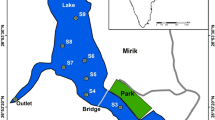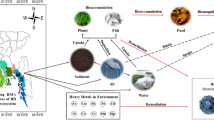Abstract
The distribution patterns, the index of geo-accumulations (MIgeo), and the enrichment ratios (ER n ) of the contaminant metals: Fe, Mn, Zn, Cu, Pb, and Ni were studied in gravel, sand, mud, coarse, medium, and fine sediment fractions of the uppermost layer of the bottom sediments collected from 12 stations covering the northern part of Safaga Bay. The distribution levels of these metals were increasing with grain size decreasing toward the central axis of the bay that extends NE–SW and southward to Safaga Harbour indicating that these metals concentrated mainly in the fine, very fine, and particulate fractions of sediments and to many anthropogenic sources. The geo-accumulation factor of Zn was more significant (MIgeo ≈ 0.62–4.23) relative to the other metals. The bay was classified as moderately to strongly polluted by Zn while it is unpolluted to moderately polluted with the other metals with accumulation sequence of: Zn>Ni>Cu>Mn≥Pb. Zn and Ni recorded the highest enrichment ratios (average ERZn ≈ 3.07 to 8.89; average ERNi ≈ 0.84 to 3.63) in the different sediment fractions relative the other metals. These enrichment ratios classified the bay as minimal enrichment, suggestive of no or minimal pollution, to significant enrichment, suggestive of a significant pollution signals with metals sequence of: Zn>Ni>Cu>Pb>Mn.








Similar content being viewed by others
References
Abd El-Wahab M, Dar MA, Mohamad TA (2005) Sediments, coral reefs and seawater interactions in some coastal lagoons, Red Sea, Egypt. Egypt J Aquat Res 31(Special Issue):69–85
Barbosa MC, Almeida MS (2001) Dredging and disposal of fine sediments in the state of Rio de Janeiro, Brazil. J Hazard Mater 85:15–38
Bell FG, Lindsay P, Hytiris N (1997) Contaminated ground and contaminated estuary sediment illustrated by two case histories. Environ Geol 32(3):191–202
Beltagy AI (1984) Metasal geochemistry of some recent marine sediments from north Red Sea. Bull Inst Oceanogr Fish ARE 10:1–12
Breault RF and Harris SL (1997) Geographical distribution and potential for adverse biological effects of selected heavy metals and organic compounds in streambed sediment in the Connecticut, Housatonic, and Thames River Basins, 1992–94. US Geol Surv Water Res Invest Rep 97–4169
Bryan GW, Langston WJ (1992) Bioavailability, accumulation and effects of heavy metals in sediments with special reference to United Kingdom Estuaries: a review. Environ Pollut 76:89–131
Campbell PGC, Tessier A (1987) Metal speciation in natural waters: influence of environmental acidification. In: Sources and fates of aquatic pollutants. American Chemical Society, Washington DC, pp 185–207
Chen Z, Mayer LM (1998) Mechanisms of Cu solubilization during deposit feeding. Environ Sci Technol 32:770–775
Chen JS, Wang FY, Li XD, Song JJ (2000) Geographical variations of heavy metals in sediments of the major rivers in eastern China. Environ Geol 39(12):1334–1340
Chester R, Lin FG, Basaham AS (1994) Heavy metals solid state speciation changes associated with the down-column fluxes of oceanic particulates. J Geol Soc Lond 151:351–360
Dar MA, El-Saharty AA (2006) Recycling and retention of some heavy metals in the mangrove sediments, Red Sea, Egypt. Egypt J Aquat Res 32(2):34–47
Dar MA, Soliman FA (2003) Anthropogenic and natural phosphorous accumulations in the fine sediments of the mangrove, Red Sea Coast. Egypt Al-Azhar Bull Sci 14(1):19–131
Dickinson WW, Dunbar GB, McLeod H (1996) Heavy metal history from cores in Wellington Harbour, New Zealand. Environ Geol 27:59–69
Edwards FJ (1987) Climate and oceanography. In: Edwards FJ, Head SM (eds) Red Sea—key environments. Pergamon Press, Oxford, pp 45–69
Folk RL (1974) Petrology of sedimentary rocks. University of Texas, Hemphill Pub. Co., 182 pages
Forstner U, Wittmann G (1981) Metal pollution in the aquatic environment, 2nd edn. Springer, Berlin Heidelberg, New York
Förstner U, Ahlf W, Calmano W, Kersten M (1990) Sediment criteria development—contributions from environmental geochemistry to water quality management. In: Heling D, Rothe P, Forstner U, Stoffers P (eds) Sediments and environmental geochemistry: selected aspects and case histories. Springer, Berlin Heidelberg, pp 311–338
Gibbs RJ (1977) Transport phases of transition metals in Amazon and Yukon rivers. Geol Soc Am Bull 88:829–843
Gnandi K, Tobschall HJ (1999) The pollution of marine sediments by heavy metals in the coastal region of Togo caused by dumping of cadmium-rich phosphorite tailing into the sea. Environ Geol 38(1):13–24
Horowitz AJ (1991) A primer on sediment-heavy metal chemistry (2nd edn). Lewis Publishers, Michigan
Kabata-pendias A (1993) Behaviour properties of heavy metals in soils. Appl Geochem Suppl 2:3–9
Lee DS, Garland JA, Fox AA (1994) Atmospheric concentrations of heavy metals in urban areas of the United Kingdom. Atmos Environ 28:2691–2713
Lee PK, Touray JC, Baillif P, Ildefonse JP (1997) Heavy metal contamination of settling particles in a retention pond along the A-71 motorway in Sologne. France Sci Total Environ 201:1–15
Loring DH (1990) Lithium—a new approach for the granulometric normalization of heavy metal data. Mar Chem 29:155–168
Loring DH, Asmund G (1996) Geochemical factors controlling accumulation of major and heavy metals in Greenland coastal and fjord sediments. Environ Geol 28(1):2–11
Madkour HA (2004) Geochemical and environmental studies of recent marine sediments and some invertebrates of the Red Sea, Egypt. Ph.D. Thesis, Faculty of Science, South Valley Univ., Egypt, 286p
Morillo J, Usero J, Gracia I (2002) Partitioning of metals in sediments from the Odiel River (Spain). Environ Int 28:263–271
Mousa AA, Ergen M (1993) Geochemistry of sediment cores from the Sea of Marmara, Eastern Trough. Bull Nat Inst Fish ARE 19:119–144
Padmalal D, Maya K, Seralathan P (1997) Geochemistry of Cu, Co, Ni, Zn, Cd and Cr in the surficial sediments of a tropical estuary, southwest coast of India: a granulometric approach. Environ Geol 31(1/2):85–93
Paetzel M, Nes G, Leifsen LQ, Schrader H (2003) Sediment pollution in the Vagen, Bergen Harbour, Norway. Environ Geol 43:476–483
Piller WE, Mansour AM (1990) The Northern Bay of Safaga (Red Sea, Egypt): an actuopalaeontological approach. II. Sediment analysis and sedimentary facies. Beitr Palaont Osterr Wien 16:1–102
Piller WE, Perversler P (1989) The northern Bay of Safaga (Red Sea, Egypt): an actuopalaeontological approach. Beitr PalaeontOe 15:103–147
Rasser M, Piller WE (1997) Depth distribution of calcareous encrusting associations in the northern red sea (Safaga, Egypt) and their geological implications. Proc 8th Int Coral Reef Sym 1:743–748
Riegl B, Piller E (1997) Distribution and environmental control of coral assemblages in northern Safaga Bay (Red Sea, Egypt). Facies 36:141–162
Riegl B, Piller WE (1999) Coral frameworks revisited: reefs and coral carpets in the northern Red Sea. Coral Reefs 18(3):241–254
Riegl B, Piller WE (2000a) Mapping of benthic habitats in northern Safaga Bay (Red Sea, Egypt: a tool for protective management. Aquat Conserv: Mar Freshw Ecosyst 10:127–140
Riegl B and Piller WE (2000b) Reefs and coral carpets in the northern Red Sea as models for organism–environment feedback in coral communities and its reflection in growth fabrics. In: Insalaco E, Skelton PW, Palmer TJ (eds) Carbonate platform systems: components and interactions. Geol Soc Spec Pub 178:71–88
Roberts H (1985) Carbonate platforms forming in a strong tidal current setting: Southern Bay of Suez. 3. Proceedings of the 5th International Coral Reef Congress, Tahiti, pp 335–341
Salomons W, Förstner U (1984) Metals in the hydrocycle. Springer, Berlin
Sheppard C, Price A, Roberts C (1992) Marine ecology of the Arabian Region. Academic, New York, 359 p
Sutherland RA (2000) Bed sediment-associated heavy metals in an urban stream, Oahu, Hawaii. Environ Geol 39(6):611–627
Vicente-Martorell JJ, Galindo-Riano MD, Garcia-Vargas M, And Granado-Castro MD (2009) Bioavailability of heavy metals monitoring water, sediments and fish species from a polluted estuary. J Hazard Mater 162(2–3):823–836
White KD, Tittlebaum ME (1985) Metal distribution and contamination in sediments. J Environ Eng 111:161–175
Author information
Authors and Affiliations
Corresponding author
Rights and permissions
About this article
Cite this article
Dar, M.A. Distribution patterns of some heavy metals in the surface sediment fractions at northern Safaga Bay, Red Sea, Egypt. Arab J Geosci 7, 55–67 (2014). https://doi.org/10.1007/s12517-012-0754-8
Received:
Accepted:
Published:
Issue Date:
DOI: https://doi.org/10.1007/s12517-012-0754-8




